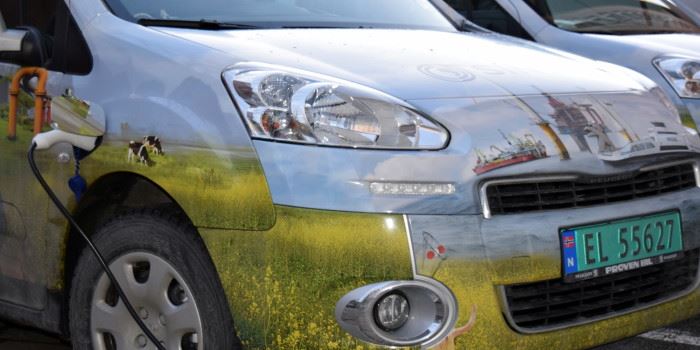As has been widely reported in the BBC and The New York Times, Norway is really big when it comes to electric vehicle sales, with electric cars making up one-fifth of all new car purchases this year. That’s good, you might think, because Norway’s electricity mainly comes from hydropower.
But Norway is still connected to Europe, which gets electricity mainly from fossil-fuel power plants. So is it a good idea for Norwegians to continue with their EV purchasing spree? The calculations two Norwegian scientists have done say yes.
An advanced “crystal ball”
They have evaluated the climate consequences of Norway replacing half of its normal passenger fleet with electric cars. These new EVs would consume some of the electricity that Norway now exports. This, in turn, would require Europe to use other sources of electricity.
“We have used our “Multi area power-market simulator” or EMPS, a kind of “crystal ball” that SINTEF has developed for the power sector. In our study we found out that half of all new electricity Europe would need would come from fossil-fired power stations – which emit CO2. But our calculations show that investing in electric cars is climate friendly nonetheless. Simply stated, electric cars will cut Norway’s greenhouse gas emissions by an amount equivalent to most of Oslo’s total greenhouse gas emissions”, says Ove Wolfgang, a research scientist at SINTEF, the largest independent research organization in Scandinavia.

Magnus Korpås, former SINTEF Research Scientist, now Professor at Norwegian University of Science and Technology, NTNU.
Click to open

Steve Völler, Research Scientist, SINTEF Energy Research
Click to open

Ove Wolfgang. Research Scientist, SINTEF Energy Research
Click to open
Here’s how Wolfgang and his colleagues Steve Völler and Magnus Korpås did their calculations.
Reduced emissions at home
If Norway continues with its “business as usual” vehicle purchases, the country’s fossil-fuelled passenger cars will emit five million tonnes of CO2 in 2020.
If half of Norway’s passenger car fleet is electric, however, that naturally means that half of the fossil-fuelled fleet has to be retired. When Norwegians stop driving these cars, half of Norway’s annual CO2 emissions also disappear – 2.5 million tonnes.
But new EVs in Norway do mean more CO2 emissions in Europe.
More fossil-fired electricity abroad
In fact, the increased demand for electricity supplied by fossil-fired power plants will result in annual CO2 emissions of 1.5 million tonnes in the rest of Europe.
However, under the EU emissions trading regime, if the coal sector produces this power, cuts of 1.5 million tonnes will have to come from some other sector in Europe. Consequently, Norway’s investment in electric vehicles will not result in any additional net CO2 emissions in Europe. But under this scenario, EVs will continue to encourage Europe’s dependence on coal.
A net cut will be the result
“This dependency will make it difficult to implement an ambitious climate policy in the form of drastic cuts in the number of allowances. But actually quantifying the implications of this is impossible. The closest we can get with our EV calculations, however, is to start with the resulting CO2 emissions cuts of 2.5 million tonnes. If we then add the CO2 emissions that would come from mainly coal-fired power plants (1.5 million tonnes), we get a net cut of one million tonnes of CO2 for Europe – or roughly the same as 75 per cent of Oslo’s greenhouse gas emissions,” says Wolfgang.
“Another benefit of replacing gasoline and diesel passenger cars with EVs would be to move CO2 emissions from a sector that is not subject to emission allowances (a non-quota sector) to a sector that is regulated (power generation). Because the transport sector is not subject to quotas for emissions allowances, many would say that it is important that Norway also do a better job of cutting its vehicle emissions,” he added.
Simulating market response
A Norwegian passenger fleet where every other car in 2020 runs on electricity will consume about 3 TWh (terawatt hours) of power annually. This is equivalent to 2.5 per cent of Norway’s hydropower production in an average year. SINTEF’s crystal ball shows how the electricity market in western Europe would respond to changes in electricity exports from Norway:
If Norway reduces its net electricity exports, the rest of Europe must increase its production accordingly. About half of the increased production will come from coal-fired power plants (mainly in Germany, Finland, the Netherlands and Denmark).
The other half will likely come mostly from bioenergy (considered climate neutral under most climate accounting) – mainly from power plants in Sweden and Finland.
Running on wind power
As time goes on, Europe’s power mix will include an ever-increasing proportion of renewable energy, a trend that will accelerate under the climate targets that have been agreed to for 2020 and beyond.
The SINTEF scientists also looked at what would happen if Norway increased its development of wind farms.
“Our calculations show a much greener impact if our electric cars get their 3 TWh of electricity from wind power. This would be the equivalent of what the Norwegian energy company Statkraft envisaged in its original wind power plans for central Norway. The combination of more electric cars and more wind power would mean that we would benefit from all of the CO2 cuts from eliminating fossil-fuel cars, or 2.5 million tonnes, an unquestionable green gain,” Wolfgang said.
He said that adding more wind power to the mix would mean Europe would also become less dependent on coal.
“That would also make it easier to cut Europe’s CO2 emission allowances, making it possible to increase ambitions for Europe’s climate policy,” Wolfgang said.


